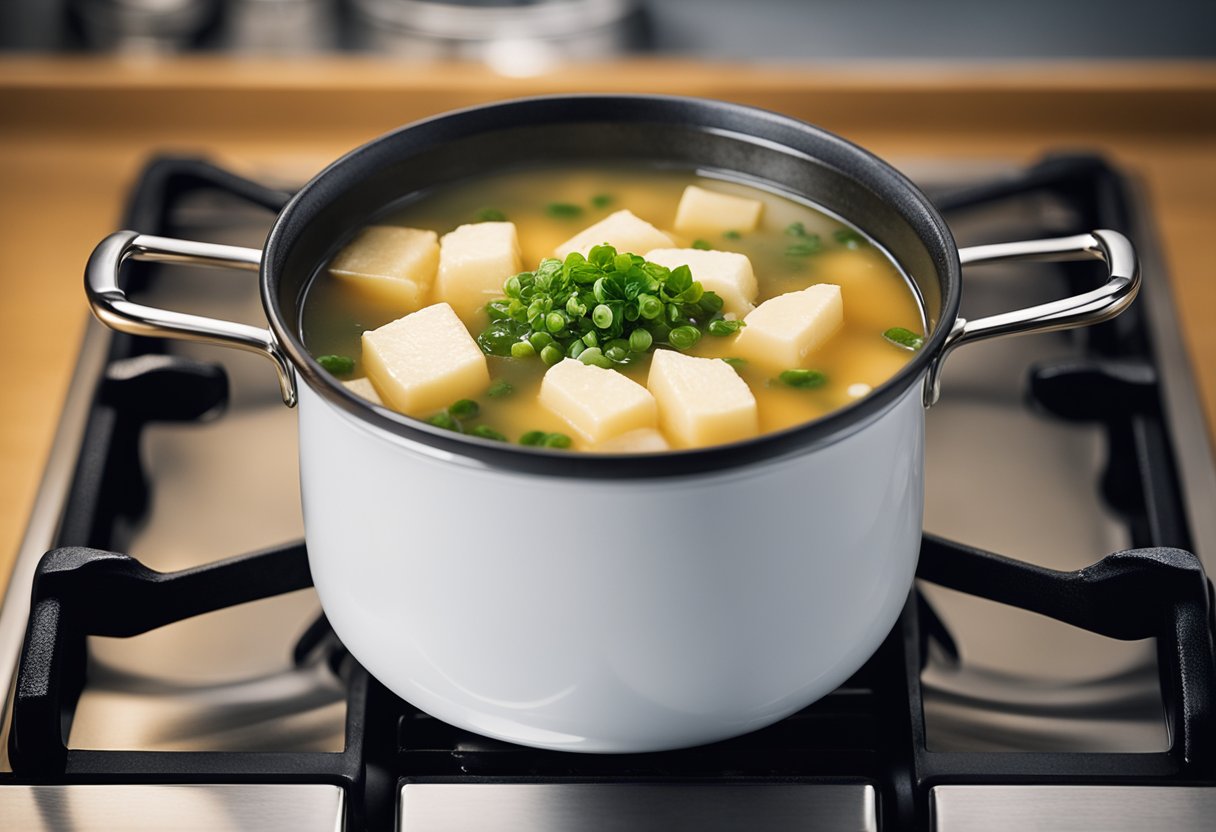I love miso soup, and I’m sure many of you do too. It’s a healthy and delicious soup that can be enjoyed any time of the day.
But what do you do when you have leftover miso soup? Can you reheat it? And if so, how do you do it without losing its nutritional value, probiotics, and flavor?

In this article, I will answer these questions and provide you with some tips and best practices for reheating miso soup.
I will also share some common mistakes to avoid and answer some frequently asked questions about miso soup. So, if you’re ready to learn how to reheat miso soup safely and maintain its quality and flavor, keep reading.
Key Takeaways
- Miso soup can be reheated safely, but it’s important to do it properly to maintain its nutritional value, probiotics, and flavor.
- Storing miso soup in the fridge or freezer can help you preserve it for later use, but you need to follow some guidelines to ensure its safety and quality.
- To reheat miso soup safely and maintain its quality and flavor, you need to avoid boiling it, use low to medium heat, and add the miso paste at the end.
Understanding Miso Soup

Miso soup is a traditional Japanese dish that has been enjoyed for centuries. It is a flavorful and nutritious soup that is made with miso paste and dashi, a Japanese stock made from kelp and dried bonito flakes.
Ingredients and Flavor Profile
Miso paste is the main ingredient in miso soup. It is made from fermented soybeans, rice or barley, and salt.
The fermentation process gives miso paste its umami flavor, which is a savory taste that is often described as meaty or brothy. The longer the fermentation process, the stronger the flavor of the miso paste.
Dashi is the second main ingredient in miso soup. It is a flavorful Japanese stock that is made from kelp and dried bonito flakes. The combination of miso paste and dashi creates a rich and savory broth that is full of umami flavor.
Other ingredients that are commonly added to miso soup include tofu, scallions, seaweed, and mushrooms. These ingredients add texture, flavor, and nutrition to the soup.
Health Benefits
Miso soup is not only flavorful but also nutritious. Miso paste is a good source of protein, vitamins, and minerals. It also contains probiotics, which are beneficial bacteria that can improve gut health.
Dashi, the other main ingredient in miso soup, is also a good source of nutrients. Kelp, one of the main ingredients in dashi, is rich in iodine, which is important for thyroid health. Bonito flakes, another main ingredient in dashi, are rich in protein and vitamins.
In conclusion, miso soup is a flavorful and nutritious dish that is easy to make and can be enjoyed any time of the day. It is a great source of protein, vitamins, minerals, and probiotics, and is a delicious way to improve gut health.
Storing Miso Soup

When it comes to storing miso soup, there are a few things to keep in mind to ensure it stays fresh and tasty for as long as possible.
In this section, I will cover the best practices for refrigerating and freezing miso soup.
Refrigeration Best Practices
The first step in storing miso soup is to transfer it to an airtight container. This will help prevent air from getting in and causing the soup to spoil more quickly. You can use any type of container that has a tight-fitting lid, such as a plastic container or a glass jar.
Once you have transferred the miso soup to the container, place it in the fridge as soon as possible. It’s important to refrigerate the soup within two hours of cooking it to prevent bacteria from growing. You can keep miso soup in the fridge for up to four days.
When reheating miso soup that has been refrigerated, it’s important to do so gently. You can use a microwave or a stove to reheat the soup, but be sure to use low heat and avoid boiling it. This will help preserve the flavor of the miso.
Freezing Techniques
If you have leftover miso soup that you won’t be able to consume within four days, you can freeze it to extend its shelf life.
To freeze miso soup, transfer it to an airtight container and leave some room at the top for expansion. Alternatively, you can freeze miso soup in ice cube trays and then transfer the cubes to a freezer bag.
Miso soup can be frozen for up to six months. When you’re ready to use it, simply thaw it in the fridge overnight and then heat it up gently on the stove or in the microwave.
Remember that miso soup should never be refrozen once it has been thawed. If you have leftover miso soup that has been thawed, be sure to consume it within two days to prevent it from going bad.
By following these best practices for storing miso soup, you can ensure that it stays fresh and delicious for as long as possible.
Reheating Miso Soup Safely

When it comes to reheating miso soup, there are two main methods you can use: the stove and the microwave.
Regardless of which method you choose, it’s important to do so safely to ensure the soup tastes just as good as it did the first time around.
Using the Stove
To reheat miso soup on the stove, you’ll need a saucepan and a gentle heat source. Pour the soup into the saucepan and warm it over low to medium heat for 5-7 minutes.
Be careful not to let the soup come to a boil, as this can cause you to lose some of the miso flavor. If you’re in a hurry, you can turn up the heat a bit, but still avoid boiling the soup.
When reheating miso soup, it’s important to use a gentle heat source to avoid overcooking the soup.
Overcooking can cause the soup to become too thick or mushy, which can change the texture and flavor of the soup. To avoid this, use a low heat and stir the soup frequently to ensure it heats evenly.
Microwave Method
If you’re short on time, you can also reheat miso soup in the microwave. To do this, pour the soup into a microwave-safe bowl and heat it for 1-2 minutes. Be sure to stir the soup after each 30-second interval to ensure it heats evenly.
When reheating miso soup in the microwave, it’s important to avoid overheating the soup. Overheating can cause the soup to become too hot and lose its flavor and texture. To avoid this, heat the soup in short intervals and stir it frequently.
Regardless of which method you choose, be sure to reheat miso soup safely to ensure it tastes just as good as it did the first time around. By using a gentle heat source and avoiding boiling the soup, you can enjoy a delicious and flavorful bowl of miso soup every time.
Maintaining Quality and Flavor

When reheating miso soup, it is essential to maintain its quality and flavor. Here are some tips to help you achieve the best results.
Avoiding Overheating
Overheating miso soup can cause it to lose its flavor and texture. It is essential to avoid boiling the soup during the reheating process.
Instead, pour the soup into a cold saucepan and heat it gently over low to medium heat for 5-7 minutes. This will help preserve the miso flavor and prevent the soup from becoming too thick.
Stirring Techniques
Stirring the miso soup while reheating can help distribute the heat evenly and prevent overheating.
Use a ladle or spoon to stir the soup gently, making sure to avoid stirring too vigorously, which can cause the tofu and seaweed to break apart. Stirring the soup can also help blend the flavors and make it more flavorful.
To summarize, when reheating miso soup, it is essential to avoid overheating and use gentle stirring techniques to maintain its quality and flavor. By following these tips, you can enjoy a delicious and flavorful bowl of miso soup every time.
Best Practices for Reheating Miso Soup
As a miso soup lover, I know that reheating miso soup can be tricky. If you don’t reheat it properly, you can end up with a lumpy, grainy, or bland soup.
However, if you follow these best practices for reheating miso soup, you can enjoy a delicious and satisfying bowl of miso soup every time.
Adjusting for Add-ins
If you plan to add ingredients like scallions, green onions, tofu, or vegetables to your miso soup, it’s best to add them after reheating the soup. This will ensure that the add-ins retain their texture and flavor.
When reheating miso soup, it’s important to use low heat and avoid boiling the soup. Boiling can cause the miso paste to break down and lose its flavor. Instead, gently warm the soup over low heat and stir it frequently.
Serving Recommendations
When serving reheated miso soup, it’s best to use a ladle to transfer the soup to a bowl. This will help ensure that the soup is evenly distributed and that any add-ins are evenly distributed throughout the soup.
If you’re serving miso soup with rice or noodles, it’s best to serve them separately and add them to the soup bowl just before eating. This will help ensure that the rice or noodles don’t become mushy or overcooked.
In conclusion, reheating miso soup can be a bit tricky, but by following these best practices, you can enjoy a delicious and satisfying bowl of miso soup every time. Just remember to adjust for add-ins and use low heat when reheating the soup.
Frequently Asked Questions

What is the best method to reheat miso soup without losing its flavor?
The best way to reheat miso soup is on the stovetop using low heat. Avoid boiling the soup as this can destroy the flavor and nutrients. Add fresh ingredients and stir gently to prevent the soup from sticking to the bottom of the pot.
Can miso soup be reheated in a microwave, and if so, what precautions should be taken?
Yes, miso soup can be reheated in a microwave. However, it is important to be careful not to overheat the soup as this can cause it to lose its flavor and texture. To prevent this, heat the soup in short intervals and stir frequently.
How can you tell if your miso soup has spoiled and should not be consumed?
Spoiled miso soup has a sour smell and taste and may have a cloudy appearance. If you notice any of these signs, it is best to discard the soup and make a fresh batch.
What is the shelf life of miso soup when stored in the freezer?
When stored in an airtight container, miso soup can last up to six months in the freezer. However, it is best to consume the soup within three months for optimal flavor and texture.
Is it possible to eat miso soup cold, or does it need to be warmed up?
Miso soup can be consumed cold, but it is typically served hot. If you prefer to eat it cold, make sure to store it in the refrigerator and consume it within a few days.
Does reheating miso soup affect its health benefits, particularly the probiotics?
Reheating miso soup can affect its probiotic content, as high temperatures can kill the live cultures. To preserve the probiotics, it is best to avoid reheating the soup above 115°F (46°C).







